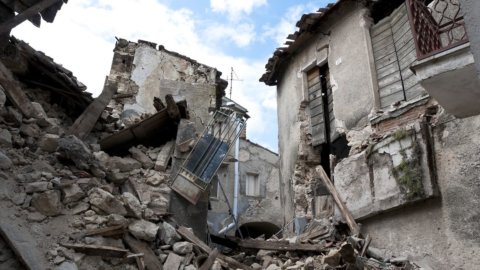Terremoti, alluvioni, frane. In Italia il rischio di essere colpiti da una catastrofe naturale è più alto che nel resto d’Europa, eppure quasi nessuno stipula un’assicurazione per tutelarsi. Secondo una recente analisi pubblicata dall’Istituto di vigilanza sulle assicurazioni (Ivass), nel nostro Paese sono coperte da polizze contro le calamità appena 836mila abitazioni, il 2,4% del totale. Di queste, 270mila sono assicurate solo contro il rischio terremoto e 260mila solo contro le alluvioni, mentre superano di poco quota 300mila i contratti multi-rischio, che proteggono da entrambi i pericoli. Peraltro, la diffusione di queste assicurazioni non è correlata al livello di rischio nelle varie zone del Paese: la maggior parte delle abitazioni protette si trova nel Nord Ovest, seguito da Nord Est e Centro, mentre al Sud e sulle isole questo genere di tutela è una rarità.
Il pericolo, invece, è distribuito in modo molto più regolare. I Comuni italiani esposti a un rischio sismico di livello medio-alto sono 5.157 e insieme raccolgono 36,9 milioni di persone, cioè più della metà della popolazione italiana. Per quanto riguarda invece le alluvioni, i Comuni a rischio medio-alto sono molti meno (237), ma nel complesso arrivano comunque a sfiorare i tre milioni di residenti. Dal 1950 si stimano in Italia oltre 5mila vittime per i terremoti e circa 1.200 tra morti e dispersi per le alluvioni.
Ma allora perché gli italiani sono tanto restii ad assicurarsi? Il nostro Paese si distingue nel panorama internazionale per una gestione dei danni da calamità naturali affidata quasi esclusivamente all’intervento statale in fase di ricostruzione. A questo si associa la ridotta propensione delle famiglie italiane ad acquistare coperture danni non obbligatorie.
Secondo l’Ivass, è necessario aumentare la cooperazione pubblico-privato in questo settore, ad esempio affidando allo Stato la gestione emergenziale e gli interventi sulle infrastrutture e alle compagnie assicurative i finanziamenti per ripristinare l’edilizia privata. L’Istituto rileva che un’estensione della protezione assicurativa contro i rischi naturali sarebbe nell’interesse dell’Erario, visto che il bilancio dello Stato è continuamente esposto al rischio di spese non previste per interventi di soccorso. Un contributo potrebbe arrivare anche dalle banche, che già offrono coperture assicurative contro le calamità naturali sulle abitazioni gravate da mutuo.
Inoltre – sottolinea ancora l’Ivass – si potrebbe immaginare uno scenario in cui lo Stato offra servizi di assicurazione o di riassicurazione veri e propri tramite società a capitale pubblico. Quanto ai prezzi, per evitare disparità a livello territoriale interverrebbe il meccanismo di solidarietà, in base al quale i premi delle aree maggiormente a rischio sarebbero finanziati anche da quelli delle aree più sicure. Senza dimenticare l’azione di contenimento dei costi realizzabile tramite la leva fiscale, che potrebbe agire in modo diretto, con sgravi sul premio assicurativo pagato, oppure in via indiretta, con agevolazioni sulla messa in sicurezza degli edifici.
L’Ivass si spinge a ipotizzare un intervento del legislatore che renda obbligatoria la copertura assicurativa sui pericoli naturali. Tuttavia, un provvedimento simile – pur consentito dalle norme europee – sarebbe certamente percepito dalla maggioranza delle persone come un intollerabile aggravio fiscale. E, con ogni probabilità, un sistema detrazioni non basterebbe a evitare le proteste.





